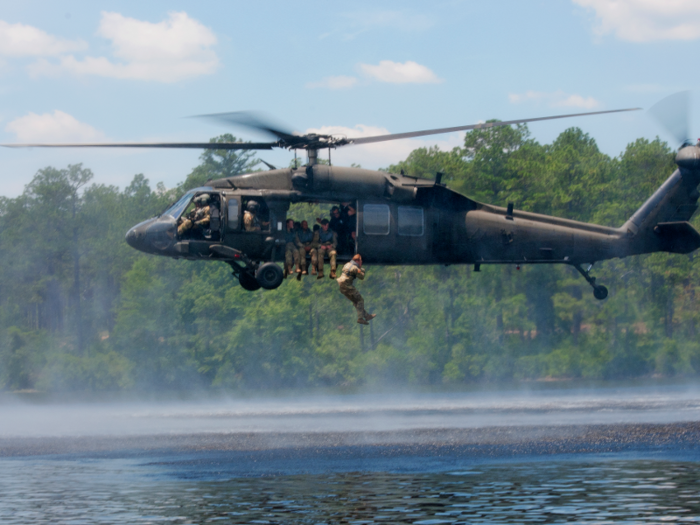
Fort Bragg is home to the Airborne and Special Operations Forces. Established in 1918 as Camp Bragg, the base is one of the largest military installations in the world and employs about 57,000 military personnel, according to the Army.
Fort Bragg is also named after Braxton Bragg, a Confederate general and West Point graduate who was born in Warrenton, North Carolina. The Army's history of the base doesn't mention Bragg's Confederate ties, saying instead that the base bears his name because of his success in the Mexican-American War that began in 1846.

According to the National Park Service, Bragg had resigned from the Army and "was overseeing his Louisiana plantation when the [Civil] war began."
Bragg was apointed a brigadier general in 1861, commanding defenses from Pensacola, Florida to Mobile, Alabama. He later commanded the Army of Tennessee, and after a series of defeats, went to Richmond to advise Confederate President Jefferson Davis. He died in 1876.

Fort A.P. Hill, located near Bowling Green, Virginia was established June 11, 1941 as a training installation, a role it still serves today. The Army estimates that 80,000 troops from all branches of the military trained here each year during the War on Terror. It also hosted the Boy Scout Jamboree every four years from 1981 to 2005, and in 2010 as well.
The Army calls A.P. (short for Ambrose Powell) Hill a "distinguished" Confederate general, and notes that John Wilkes Booth was killed nearby.

Hill was born in Culpeper, Virginia, and was a graduate of West Point. He died in 1865 at the Third Battle of Petersburg, according to Military.com.

Fort Lee, in Prince George County, Virginia, is named for Robert E. Lee, the Virginia general who was a slave owner. Fort Lee was established as Camp Lee in 1917, but the original site was dismantled after the end of World War I, but re-established during World War II. In 1950, it was formally renamed Fort Lee, and it's now the Army's third-largest training site.

The commander of the Confederate States Army, Lee surrendered on April 9, 1865. He was reportedly a cruel slavemaster, breaking up slave families, ordering runaway slaves to be mercilessly whipped, and captured and enslaved free Black people when his army fought in Pennsylvania, according to The Atlantic.

Fort Pickett is a Virginia National Guard installation near Blackstone, Virginia. It was established as Camp Pickett on July 3, 1942 at 3:00 PM — 79 years to the hour after Maj. Gen. George E. Pickett began his charge at the Battle of Gettysburg, as the Virginia National Guard notes.
Fort Pickett hosts the Virginia National Guard and Air Guard.

Pickett graduated last in his class from West Point in 1846. He lost more than half his command during the charge up Cemetery Ridge during the Battle of Gettysburg in 1863, according to the National Parks Service.

Fort Gordon was established as Camp Gordon in Georgia during World War II. German and Italian prisoners of war were kept there during the war, and the remains of 22 POWs are buried there, according to the Army.

Gordon rose to become a Confederate general.
Source: National Parks Service

Brig. Gen. Henry Benning was "an outstanding lawyer-turned-soldier from Columbus," and the base honoring him was founded October 7, 1918, according to the Army.

Fort Rucker, an Army Aviation training base in Alabama, was established May 1, 1942. Edmund Rucker was a Confederate colonel — not a general — and became an industrial leader in Alabama after the war. German and Italian prisoners of war were held nearby during World War II, according to the Army.

Louisiana's National Guard calls Camp Beauregard, located in Pineville, Louisiana, home. Beauregard was a West Point graduate, and championed the use of what we now recognize as the Confederate flag, according to The Washington Post.

Polk was a second cousin of US President James Polk, and died during the Battle of Atlanta. Polk was a West Point graduate but served as an Episcopal priest until he joined the Confederacy, according to the Encyclopedia Britannica.
Fort Polk, located in central Louisiana, hosts the Army's Joint Readiness Training Center.

Fort Hood opened in 1942 and is now the largest active-duty armored post in the Armed Forces, according to the Army. It's named for John Bell Hood, who was a West Point graduate who served in the US Army until the Civil War, when he joined the Confederacy, according to the Encyclopedia Britannica.
 6 reasons why you should visit Ladakh this summer
6 reasons why you should visit Ladakh this summer
 TVS iQube gets a new variant priced under ₹1 lakh, ST variant gets a bigger battery
TVS iQube gets a new variant priced under ₹1 lakh, ST variant gets a bigger battery
 As English players begin their premature IPL exodus, Gavaskar calls for action against England Cricket Board
As English players begin their premature IPL exodus, Gavaskar calls for action against England Cricket Board

Copyright © 2024. Times Internet Limited. All rights reserved.For reprint rights. Times Syndication Service.